|
Afrika
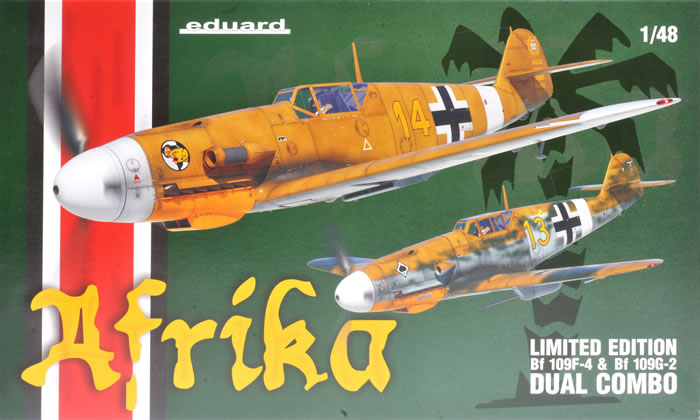
Eduard Limited Edition Dual Combo
1/48 scale
S
u m m a r y |
| Catalogue Number: |
Eduard Kit No. 11116 - Afrika Limited Edition Bf 109 F-4 & Bf 109 G-2 Dual Combo |
| Scale: |
1/48 |
| Contents and Media: |
Approx. 370 parts in grey coloured plastic (many not used); 28 parts in clear (16 not used); two colour photo-etched frets; self-adhesive die-cut masking sheet; markings for 12 aircraft |
| Price: |
USD$89.95 plus shipping,
available online now from Eduard
GBP£58.70 (£48.92 Export Price) plus shipping available from Hannants |
| Review Type: |
FirstLook |
| Advantages: |
Two complete models; accurate; high level of detail; outstanding surface features including crisply recessed panels and subtle rivet lines where appropriate; Resin trop filters for both models; includes colour photo-etched parts; separate control surfaces; many useful options including alterative propeller blades, wheels, oil cooler housings, bomb racks, trop filter and supercharger intakes (some parts not applicable for this kit); high quality decals; includes die-cut canopy masks. |
| Disadvantages: |
Toothy exhaust stacks. |
| Conclusion: |
Eduard's 1/48 scale Bf 109 F-4 and G-2 kits are accurate, well detailed and boast surface textures as good as anything currently available. The addition of the four resin parts and the 12 tropical themed marking options is a real bonus.
I have already built three of Eduard's 1/48 scale Bf 109 G kits and they were a joy to work on - straightforward engineering, brilliant fit and a gorgeous result once they're finished. I have no reason to expect that these kits will be any different. |
Reviewed by Brett Green

Eduard's 1/48 scale Messerschmitt Bf 109 F-4 ProfiPACK will be available online from Squadron.com
The Messerschmitt Bf 109 F delivered a major transformation to the famous Augsburg Eagle. The airframe was streamlined with a newly designed engine cowling, large spinner, rounded wing tips, revised flaps and many mechanical modifications compared to the earlier Bf 109 E.
The Bf 109 F entered service in 1941 at around the same time as the RAF introduced the Spitfire Mk.V. RAF Fighter Command also switched to offensive operations over France and Belgium during this period, creating a new challenge for the Luftwaffe.
The new Spitfire was superior to the Bf 109 F in most respects, and it would not be until early 1942 with the general introduction of the Focke-Wulf Fw 190 that a Luftwaffe fighter aircraft would gain a temporary upper hand over the English Channel.
Despite this see-sawing combat on the Channel Front, the Messerschmitt Bf 109 F achieved stunning success over the grassy steppes and frozen tundras of Russia, and the harsh desert of North Africa during 1941 and 1942.
The Bf 109 G-series was developed from the largely identical F-series airframe, although there were detail differences. Modifications included a reinforced wing structure, an internal bullet-proof windscreen, the use of heavier, welded framing for the cockpit transparencies, and additional light-alloy armour for the fuel tank. It was originally intended that the wheel wells would incorporate small doors to cover the outer portion of the wheels when retracted. To incorporate these the outer wheel bays were squared off. Two small inlet scoops for additional cooling of the spark plugs were added on both sides of the forward engine cowlings. A less obvious difference was the omission of the boundary layer bypass outlets, which had been a feature of the F-series, on the upper radiator flaps.
Like most German aircraft produced in World War II, the Bf 109 G-series was designed to adapt to different operational tasks with greater versatility; larger modifications to fulfil a specific mission task, such as long-range reconnaissance or long-range fighter-bomber, were with "Rüststand" and given a "/R" suffix, smaller modifications on the production line or during overhaul, such as equipment changes, were made with kits of pre-packaged parts known as Umrüst-Bausätze, usually contracted to Umbau and given a "/U" suffix. Field kits known as Rüstsätze were also available but those did not change the aircraft designation. Special high-altitude interceptors with GM-1 nitrous oxide injection high-altitude boost and pressurized cockpits were also produced.

The newly fitted Daimler-Benz DB 605A engine was a development of the DB 601E engine utilised by the preceding Bf 109 F-4; displacement and compression ratio were increased as well as other detail improvements to ease large-scale mass production. Takeoff and emergency power of 1,475 PS (1,455 hp, 1,085 kW) was achieved with 1.42 atm (42.5 inches/6.17 lbs) of boost at 2,800 rpm. The DB 605 suffered from reliability problems during the first year of operation, and this output was initially banned by VT-Anw.Nr.2206, forcing Luftwaffe units to limit maximum power output to 1,310 PS (1,292 hp, 964 kW) at 2,600 rpm and 1.3 atm manifold pressure (38.9 inches/4.4 lbs). The full output was not reinstated until 8 June 1943 when Daimler-Benz issued a technical directive. Up to 1944, the G-series was powered by the 1,475 PS Daimler-Benz DB 605 driving a three-blade VDM 9-12087A variable-pitch propeller with a diameter of 3 m (9.8 ft) with even broader blades than used on the F-series. Pitch control, as on the 109F, was either electro-mechanical (automatic) or manual-electric using a thumb-switch on the throttle lever.[61] From 1944 a new high-altitude propeller with broader blades was introduced, designated VDM 9-12159, and was fitted to high-altitude variants with the DB 605AS or D-series engines.
The early versions of the Bf 109G closely resembled the Bf 109 F-4 and carried the same basic armament; however, as the basic airframe was modified to keep pace with different operational requirements, the basically clean design began to change. *
* Historical summary courtesy of Wikipedia
Eduard released their 1/48 scale Messerschmitt Bf 109 F-4 in September 2016 and their G-2 in early 2017.
They have now combined these two kits in a tropical themed release - "Afrika" Limited Edition Bf 109 F-4 & Bf 109 G-2 Dual Combo.
Please note that both of these kits are the new and improved tooling that appeared first appeared in 2016.
Eduard's "Afrika" Dual Combo includes parts to build two full kits. There are around 370 parts in grey coloured plastic (many not used); 28 parts in clear (16 not used); two colour photo-etched frets; self-adhesive die-cut masking sheet and markings for 12 aircraft.
Thumbnail panels:1 | 2 | 3 | 4 | 5
Bonus BRASSIN resin parts are included in this "Afrika" release.

These are two sets of tropical filters with replacement supercharger intakes. The trop filters are cast with the clamshell doors shut.

The fuselages are presented as a full-length side per half, including the fin moulded in place, so there should not be any dramas with aligning multiple parts. The upper cowl is moulded to each fuselage half too, with inserts provided for the gun troughs.
In 2013, Eduard’s Spitfire family set a new benchmark for 1/48 scale surface detail, and this latest generation of Bf 109 Fs and Gs are equally impressive in this regard. Panel lines are very crisp, fine and even. Lines of rivets are present, but they are very subtle.
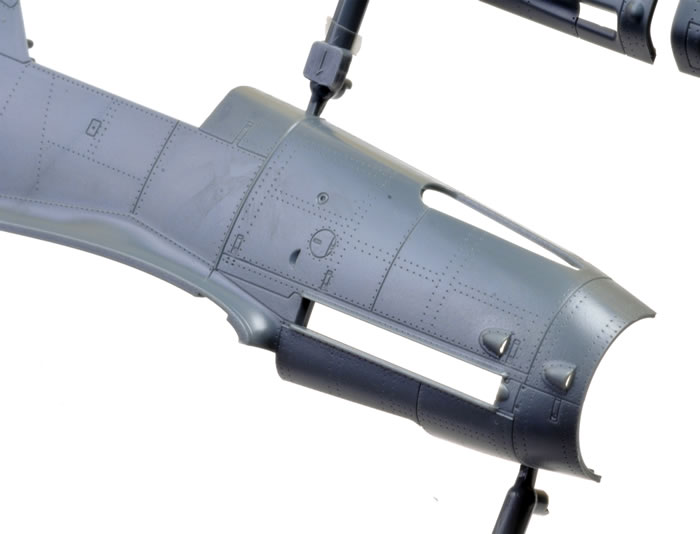
Fabric matches this high standard, with strip and stitching texture beautifully presented on the control surfaces. If you look closely enough, you will even see the zig-zag pinking edges on the fabric strips.
Eduard combines plastic and colour photo-etched parts in their ProfiPACK, resulting in a very high level of detail straight from the box. The cockpit benefits most from the dedicated Bf 109 G-2 coloured photo-etch with a nice multi-layered instrument panel, harness straps and other coloured details. Half-tones and shading seem to have taken a great leap forward on this photo-etched fret, especially the harness straps.

A second brass photo-etched fret supplies more detail for the exterior.
Canopies are offered in three pieces with the windscreen, fixed rear section and poseable centre. The inclusion of the clear fuel line is a welcome touch. The inspection tube may be masked so that it remains clear after painting.
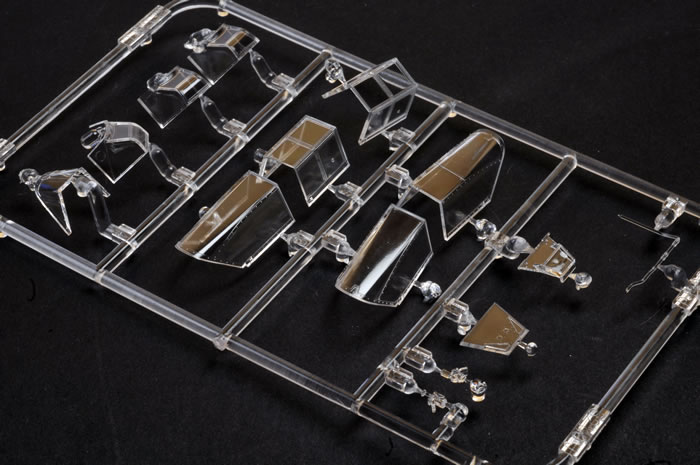
The wheel wells are nicely detailed. Eduard depicts the wheel well sidewalls with the zippered canvas covers at the front and rear. The fabric texture looks good, and the zipper is represented by a raised line.
The exhausts are supplied in one piece for each side with an optional moulded-on shroud. The centreline weld beads are present, and each of the stacks are hollowed out at the end.
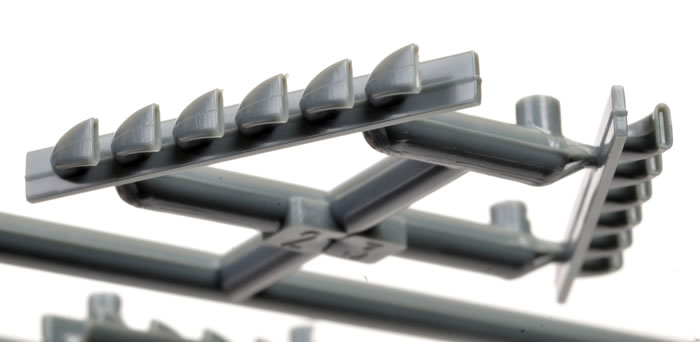
Three propeller assembly options are supplied with nice pitch collar and hub detail.
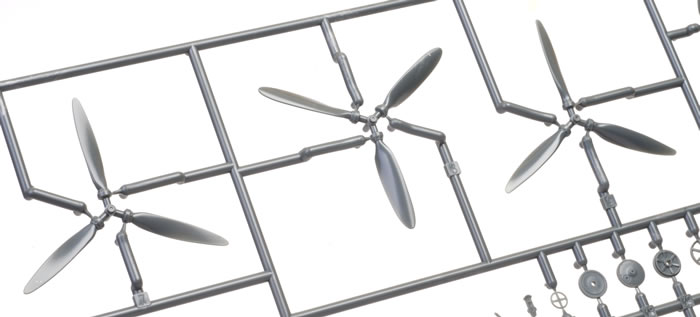
The kits are broken down conventionally.
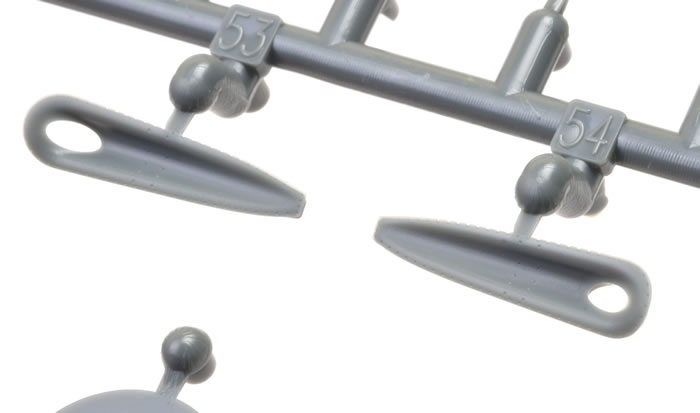
The upper and lower cowls are moulded as part of the fuselage sides.
Wings with and without the wheel bulges are included on the Bf 109 G-2 sprues. Check your references to confirm which will apply to your marking choice.
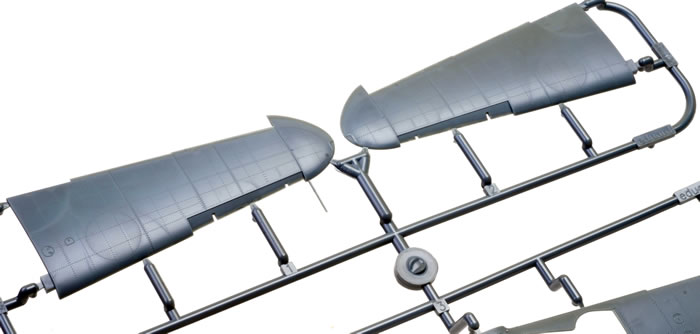
In fact, there are a quite a number of options on the sprues that apply to earlier or later versions, so pay attention to the instructions.
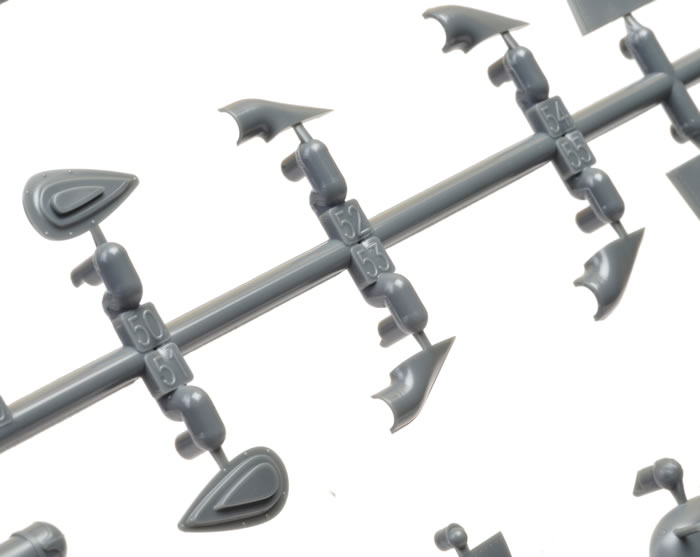
Your spares box will enjoy a boost!
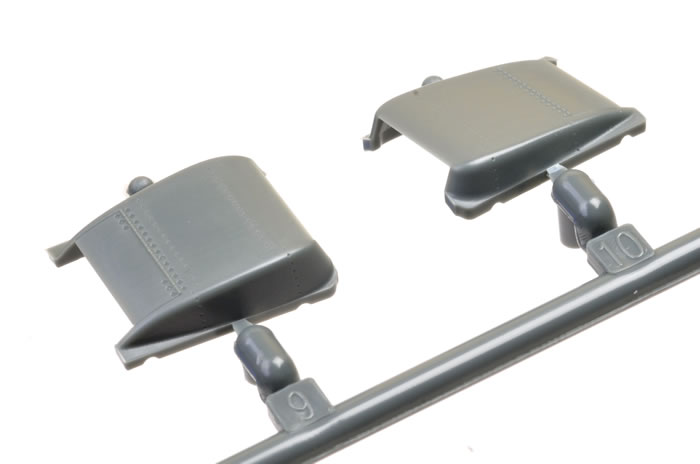
The wing tips are moulded as part of the upper wing halves with solid navigation lights and the pitot tube moulded in place.
All control surfaces are separate, including leading edge slats, ailerons, flaps, elevators and rudder. The ramps at the leading edges of the radiator housings and the cooling flaps at the back of the oil coolers are moulded shut. All the radiator faces are supplied as photo-etched parts.
Many options are offered on the sprues including a drop tank, bombs, bomb racks and different styles of wheel hubs. Some of these relate to earlier and later Bf 109 G or F versions and do not apply, but others – even though they are marked “not for use” – might come in handy for the enterprising modeller.
Check your references to see which of these features is present on your preferred subject – a number of different combinations are possible.
Markings
Markings are supplied for twelve tropical themed Messerschmitt Bf 109 F-4s and G-2s. These have been printed by Cartograf.

Stencil markings for both aircraft are printed on the large single sheet. Printing, colours and registration are perfect on my sample.
Eduard's 1/48 scale Bf 109 F-4 and G-2 kits are accurate, well detailed and boast surface textures as good as anything currently available. The addition of the four resin parts and the 12 tropical themed marking options is a real bonus.
I have already built three of Eduard's 1/48 scale Bf 109 G kits and they were a joy to work on - straightforward engineering, brilliant fit and a gorgeous result once they're finished. I have no reason to expect that these kits will be any different.
Thanks to Eduard for the sample.
Review Text Copyright © 2018 by
Brett Green
Page Created 2 July, 2018
Last updated
2 July, 2018
Back to HyperScale Main Page
Back to Reviews Page |
